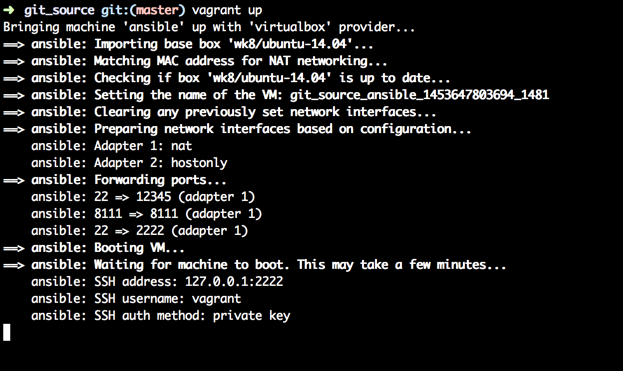
There were a few downsides to this approach: it required inclusion of the JJG-Ansible-Windows script/project in the repository, terminal output was passed through without color (so it's harder to read playbook output), terminal output was had a long delay, and the JJG-Ansible-Windows shell script itself isn't as widely tested as a solution baked into Vagrant. Night rather than a cup of coffee! It is a pretty simple process though.# Use Ansible provisioner if it's installed on host, JJG-Ansible-Windows if not.Ĭonfig.vm.provision "ansible" do |ansible|Īaybook = "#/provisioning/JJG-Ansible-Windows/windows.sh" Take some time as you will be copying large files - you may want to leave it over If you’ve already got a few boxes and/or VirtualBox VMs setup then this process can Help without slowing down performance too much.
VAGRANT ANSIBLE FREE
To free up space a USB 3.0 external HDD can really Vagrant and Ansible will be storing their large VMs and files on your limited capacity They’re often set as the primary drive for the machine. It is rare for a computer not to contain an SSD drive of some sort these days and Moving the Vagrant and VirtualBox VMs to an external HDD Both of their configurations are pretty straight forwardĪnd dealt with on their respective project pages so I won’t duplicate effort here. Hostsupdater willĪutomatically add the IP address and host name of the project to your hosts file The former aims to prevent duplicate package downloads forĪ given Vagrant box so that subsequent provisions are faster. In most of the configurations I prepare I also make use of vagrant-cachier and
VAGRANT ANSIBLE INSTALL
#!/usr/bin/env bash sudo apt-get update sudo apt-get install -y python-software-properties sudo add-apt-repository -y ppa:ansible/ansible sudo apt-get update sudo apt-get install -y ansible cp /vagrant/ansible/hosts/vagrant /etc/ansible/hosts -f chmod 666 /etc/ansible/hosts cat /vagrant/ansible/files/authorized_keys > /home/vagrant/.ssh/authorized_keys sudo ansible-playbook /vagrant/ansible/playbook.yml -connection =local Some non-config related tips Handy plugins Ubuntu/Debian Vagrant boxes, but it could be adapted for other POSIX systems. Inventory and finally running the playbook locally on the box. So installing Ansible dependencies, then Ansible, setup SSH keys, link the Ansible This shell script will handle the base setup of the box before Ansible can run. vm.provision :shell, path: "ansible/windows.sh" end end

playbook = "ansible/playbook.yml" ansible.

vm.provision "ansible" do |ansible | ansible. configure( "2") do |config | ansible_inventory_dir = "ansible/hosts" config. In vagrant.yml you can have a structure like: I am calling this file vagrant.ymlĪnd I have it sat at the same level as Vagrantfile in my projects. Thread between Ansible and Ruby (of course) is that they both parse YAML so aĬentral config file is going to be the ticket. Your provisioning scripts (Ansible, etc) and the Vagrantfile can read. One way to work around this is to use a universal configuration file that both
VAGRANT ANSIBLE WINDOWS
Windows machines is discussed further on. You need to pass the parameters in two locations. If you need to support machines thatĪnsible cannot run on then you’ll prefer the central configuration file as otherwise You can use a central file or pass the information as arguments toĪnsible from the Vagrant provision commands. There are at least two ways to achieve this - each with their respective advantagesĪnd pitfalls. Same configuration details need for the Vagrantfile will likely also be required Rather unhelpful Vagrantfile, which is a Ruby script underneath in reality. Recently, though I got to thinking about how the configuration is bound up in a

This is unbelievably handy and it really helps to reduce the kind of bugs that areĭifficult to track down - “it works on my machine!” Shared configuration
VAGRANT ANSIBLE CODE
This provides an easy to build environment as close to productionĪs possible that all developers can easily create from the source code repository.Ī simple vagrant up and the associated Ansible scripts will handle all of theĬonfiguration and package installation for the VM. I use both Vagrant and Ansible to run and provision development virtual machines for


 0 kommentar(er)
0 kommentar(er)
